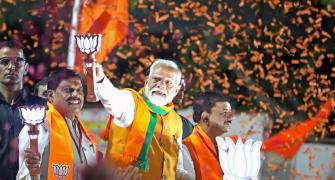Sixty-four actors and dancers have gathered at the Royal Albert Hall, close to Edison in New Jersey, on a warm fall evening for the dress rehearsal of the musical Ram Leela on a Monday evening. Under the guidance of the veteran actress, dancer and choreographer Padma Khanna, who is also acting in the show, the artists are animated. Today they are enacting key episodes from the Ramayana to a select audience; on October 4, they would be performing at Avery Fisher Hall, one of the most famous theaters in America, making history as they take a very ancient epic to a Broadway theater -- even if it is for just one show.
Several temples, ashrams and even university departments across America and Canada have already had their Ramayana productions.
"From what I hear, Ramayana is one of the most eagerly staged of non-European epics in America," says Sampad Kachuck, a Caucasian who has directed most of the Ramayana productions at the Mount Madonna School in Santa Cruz, California, during the past three decades.
"The Ramayana is not only a wonderful vehicle for artistic and creative expression," he says, "but also for teaching positive values, and working cooperatively on a large scale."
He is a devotee of 85-year-old Baba Haridas, who founded the Hanuman Academy and Mount Madonna School over three decades ago, but Kachuck does not call himself a Hindu.
The school production is a community event, bringing parents, faculty and students together in a common enterprise, he says, adding that most of the actors and behind-the-stage participants are non-Asian.
"They are thrilled to be part of a saga that offers wonderful life lessons about loyalty and friendship, and warns against power hunger and, lust," he adds. The show has been drawing hundreds of people of Indian origin in and around Santa Cruz.
Apart from the Ramayana production, every year the Mount Madonna community celebrates the history of Indian mythology, philosophy and religion through a lavish parade through the streets of Santa Cruz.
Ramayana pageants are held in many cities and states across America, even in Utah, the predominantly Mormon state. At the recent India Fest, the 22nd annual event organized by Radha Krishna temple in Spanish Fork in the state, there was a dramatic Ramayana pageant.
"Few works of literature produced in any place at any time have been as popular, influential, imitated and successful as the great and ancient Sanskrit epic poem, the Ramayana," says Robert P Goldman, professor of Sanskrit and Indian studies, University of California, Los Angles.
Though India is the home land of the Ramayana it now belongs to the entire world and is a unique, social, cultural, spiritual, philosophical and literary treasure of the mankind.
Goldman, who has a PhD from the University of Pennsylvania, is best known for his work as the director, general editor, and a principal translator of a massive and fully annotated translation of the critical edition of ancient Indian scholar Valmiki's Ramayana. The basic edition of Goldman's work is being published in elegant, pocketbook-sized editions by New York University, funded by the John Clay Sanskrit Library.
He also points out that the Ramayana is part of the educational curriculum in schools and universities in countries worldwide. Several high schools' English literature courses in America and Canada feature the Ramayana. Universities and other institutions have held Ramayana-related literary conferences.
Goldman's thoughts are echoed by many scholars including Mary Brockington, associate of the Sanskrit Department, School of Asian Studies at the University of Edinburgh. At a recent Ramayana-related festivities at the university, Brockington offered insights into the worldwide impact of the epic.
'Perhaps more than any other story in world literature, the Bible included, the Ramayana has been imaginatively represented in a vast variety of different forms,' said a statement from the university. 'From ancient painting and sculpture, via shadow puppetry, dance, community plays and mask drama, to contemporary shrines, calendars and diwali effigies. To say nothing of an ever growing catalogue of television series, films and cartoons.'
'The Ramayana -- unlike the ancient epics of Europe, such as the Iliad, the Odyssey, Beowulf and the Ring saga, which are now the province mostly of academics and of literature classes -- is very much a living epic,' wrote bestselling author William Dalrymple in The Guardian recently. 'Bards still tour villages telling the story with the help of painted scrolls, while singers sing devotional hymns recalling the valor of Lord Rama or the faithfulness of his Sita. Even more remarkably, some castes of wandering storytellers still know the 24,000-verse epic in its entirety.'
In Ottawa and Toronto, Indonesian and Indian students have offered Ramayana performances several times in the past decade.
The York University in Toronto, which has its own Gamelan Orchestra with origin in Indonesia, has had quite a bit of success with its Ramayana productions.
The International Ramayana Institute of North America based at the Northern Illinois University in DeKalb has held many conferences and Ramayana performances in the last seven years involving scholars from India, Thailand, and Indonesia. Most of the performers are students from the greater Chicago area. Last year, Indian students offered the Ramayana through Bharat Natyam, Kuchipudi and Kathak. There were also presentations influenced by Javanese and Thai traditions.
Several universities in America and Canada including Syracuse have taped their Ramayana performances, which are often used by Indian communities and ashrams to mount their versions.
The Syracuse University South Asia Center Video library, for instance, offers a tape of an excellent Ramayana performance directed by Nany Wilkinson of a high school in Washington, who took the show to many campuses. Called Tales from India, the show staged a decade ago spoke of family life, heroes and demons and battles, and ultimately of universal truths. 'Following on a centuries-old tradition of performing the Ramayana,' the library brochure at Syracuse says, performances such as this one are an excellent way by which to bring other cultures to life for American audiences.'
The Ramayana is also produced in several cities in America and Canada at the initiative of Indonesian, Thai and Indian cultural and religious organizations.
Not every production of the Ramayana that has been seen in America has taken the traditional approach celebrating characters such as Lord Rama, his wife Sita, his brother Lakshman and his devotee Lord Hanuman.
For dancer and choreographer Mythili Prakash, offering a segment of Ramayana to American audiences in many American cities starting in Orange County, California in May 2007 offered an opportunity to remind the audiences of the message the epic holds for today.
She chose three Ramayana characters for her solo show called Stree Katha, the Untold Tragedies of Three Women in Ramayana.
'The three women I have chosen for this production are Kaikeyi, Shurpanakha, and Sita,' she wrote in her production notes. 'Although the story of Sita is commonly the most explored, the focus given to heroine Kaikeyi is uncommon, and the treatment of Shurpanakha as a woman of substance is extremely rare.'
Kaikeyi was known for her beauty, affection, intelligence, and strength, Prakash observed, but 'unfortunately found the need to validate her status in relation to a man. Her story is that of a power-driven individual, perhaps similar to a high-status corporate woman today,' she added, 'who put aside her personal values and conscience to maintain her position of "power."'
Shurpanakha, noted Prakash, is the equivalent of a modern, liberated woman who does not hold herself to the societal expectations of feminine beauty or behavioral conduct. 'She believed that her beauty, femininity, and individuality lay in her power within, an inspirational motto!. Yet her confidence and candid approach was frowned upon by society then and even today '
Sita 'is considered the "ideal woman" -- a symbol of beauty and quiet strength, but most importantly a loyal wife, and woman of dignity and restraint the epitome of society's expectations,' Prakash noted. 'Possibly the most tragic heroine, she made all the "right" decisions out of complete respect and selfless love for her husband. Isn't it ironic that her integrity was questioned time and again?'
Stree Katha encourages the viewers, she continued, 'to consider the stories of these women, and through them, examine our self-imposed societal expectations. Are these expectations fair? Do they stand in the way of our happiness? Do the stories of these women still happen today?'
For Padma Khanna, there is no radical interpretation of the Ramayana, just the celebration of a perennially popular epic.
For Khanna -- whose famous Hindi films include the 1970s hit Johnny Mera Naam -- and her husband, movie director Jagdish L Sidana, staging Ram Leela on Broadway means much more than giving their dance school Indianica high visibility. The 12-year-old school in Iselin, New Jersey, has trained nearly 700 students in Kathak as well as Bollywood dances, but it has never before tried anything remotely close to the scale of their Broadway production.
Khanna, who started her Kathak training when she was just about 7, reveres the Ramayana for the timeless life lessons it offers. She also played the mercurial Kaikeyi in the mega hit Indian television series Ramayan, aired in the 1980s.
"It is a matter of pride we have taken Ram Leela to a very prestigious venue," Sidana says. "If we find solid backing from the Indian community we would like to stage in the coming years more editions of the show not only in New York but in other cities on the East Coast."








